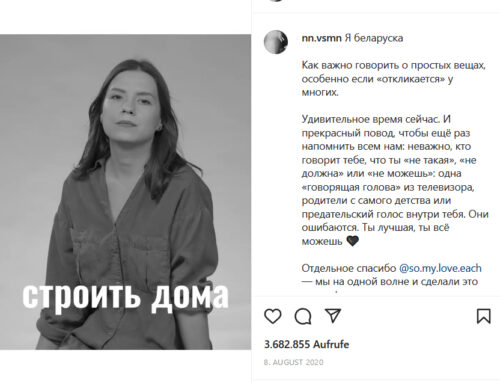This video depicts transgender activist Sylvia Rivera’s furious monologue at a demonstration in 1973. After the original recording was rediscovered and digitalised, it quickly became a major source of inspiration for present-day queer activism.
© of the Video by LoveTapesCollective
The web video Y’ALL BETTER QUIET DOWN is a digitalised version of an untitled black-and-white analogue recording from 1973 showing the rousing and inflammatory speech of American transgender activist Sylvia Rivera on the Christopher Street Liberation Day Rally in New York City. In her monologue, Rivera laments the indifference shown by the predominantly white, middle-class gay community towards the social predicament of lower-class transgender people. After having ostensibly faced vocal opposition before gaining access to the microphone, she boldly recounts the fate of her jailed “gay brothers and sisters” and continues to speak about the wide-spread sexual violence in state prisons, financial precarity as well as the overwhelming financial burdens facing those wishing to undertake a sex change and the risks involved. She then promotes her own organisation named “STAR”, an acronym for “Street Transgender Action Revolutionaries”, which, as Rivera puts it, fights for the rights of transgender people – often Queers of Colour and homeless youths – and calls attention to their concerns.
The speaker’s tremendous affective power becomes apparent in a mere matter of seconds. Rivera’s voice exudes anger and contempt, sometimes even bordering on the dramatic, before suddenly faltering, briefly sounding raspy and hoarse. Her voice cracks repeatedly, in several instances even failing momentarily. Rivera speaks with a noticeable Hispanic-American dialect, uses strong language and doesn’t shy away from recounting the physical violence she endured, informing the audience, willing or not, about several cases of sexual violence in particular. Her gestures towards the initially hostile audience express defiance, they appear provocative even to a certain degree, faking impassiveness and passive-aggressive composure in the face of her adversaries; she then even goes as far as pointing her finger at the crowd and insulting those present. However, Rivera’s energy is gradually transferred to the audience which itself acts as an amplifier by loudly repeating the slogan. Whereas Rivera was initially booed for taking centre-stage as a militant transgender activist, the reaction of the crowd, remaining invisible but nonetheless clearly audible throughout the entirety of the video, slowly changes, ultimately giving way to a thunderous chorus of cheers – the audience amplifies the noise by assuming the role of an affective resonating body.
Naturally, though, not only Rivera’s body, but also and especially the video itself plays an important part as an audiovisual medium. The recording shows unedited analogue material in black and white, shot from the low-angle view of an amateur filmer’s portable camera which (apart from the initial jumpy pans to the audience and a brief manual focus on the raised fist) remains relatively steady while following the movements of Rivera’s body – right until the rather abrupt ending. By doing so, the video evokes empathic responses from its viewers – responses indirectly aimed at protecting Rivera in her isolated position from the agitated anonymous masses. This is an example for an affective strategy we shall call the David-versus-Goliath principle – a strategy that pushes “us” towards taking the side of the supposedly weaker party in attempt to reach positive affective gratification.
Noticeable visual distortions include the visual smears caused by the magnetic tape of the video cassette as well as the characteristic blurriness and flatness of the visual plane. Furthermore, the coarseness and low-fi quality of both the analogue original and digitalised video (the latter being available in the standard YouTube format with 480×360 pixels and a mono-channel MP3 audio track) act as an “authenticity code”, as proof of the video’s historical dimension. In this sense, YouTube’s interface, including the sidebar, multiple image window sizes, comment section and list of metadata, is by no means merely a nuisance to the eye – the video’s hypermedial embedding which, while assuming a point of view facilitated by being available on a present-day digital platform looks back onto the analogue imagery of the past, is precisely what makes the whole affair so appealing. It is through this very lack of visual perfection that “we”, the viewers, ascribe to the video an air of historical-political authenticity.
A closer look into the video’s history of reception, a chronology characterised by multiple instances of artistic and activist appropriation, turns out to be particularly instructive. Whereas no details can be given on the identity of the person who originally filmed Sylvia Rivera’s speech, the video’s recent online journey to fame can indeed be traced step by step: the original tape was, most likely by pure chance, rediscovered by a former staff member of the Lesbian Herstory Archives based in New York City, digitalised in 2012 and then uploaded to the commercial video platform Vimeo. It has circulated around the Internet ever since, making its rounds on various platforms, and has been met with a strong response by queer publics. Its popularity contributed to the Sylvia Rivera Law Project, founded after Rivera’s death in 2002, eventually gaining considerable attention. In 2013, artist Conny Karlsson Lundgren, working together with Swedish performance group Kvalitétsteatern, co-produced a re-enactment named Y’ALL BETTER QUIET DOWN! / HALLA, KAN NI LUGNA NER ER! (9 minutes, HD, colour, sound), thereby giving Rivera’s original speech a more melancholic touch while splitting it up among multiple speakers.
In 2013, Vimeo user Reina Gossett uploaded another video showing the reaction of the opposing side at the same rally. In this video, a supporter of radical lesbian feminism addresses the crowd, sharply criticising Rivera for, among other things, taking the stage in the first place. She views male-to-female transgender performances overall as an insult to women – a view that is nowadays mostly regarded as transphobic. This two-minute long recording of activist Jean O’Leary is then contrasted with counter-images of two drag queens, who in turn offer a parodistic take on O’Learys speech, thus countering her criticism of the, as she puts it, “imitation of femininity”. These counter-images can be interpreted as a cautious evaluation by the filmmakers – an assessment absent from the seemingly neutral view of the original video, Y’ALL BETTER QUIET DOWN. This second video published on a later date thereby creates a new context of intertextual reference and makes the original Rivera video appear in a new light: now, the invisible crowd itself is made visible by giving a representative her chance to speak.
The 25 comments left by “viewsers” also allow conclusions to be drawn about the reactions of queer communities and LGBTI activism. Instead of being slathered with the kind of hateful propaganda that causes some LGBTI-related videos to be created in the first place, Y’ALL BETTER QUIET DOWN has so far been met with strictly positive comments by the respective communities in Europe, North America and South America. However, further evaluation reveals that this specific context, while positive, turns out to be rather diverse. One “viewser”, for example, claims to have been a witness: “I was there that day”. On the other hand, one teenager views the Rivera video in light of the current debate concerning transgender restrooms: “Oh my gosh. I love this so damn much. I thought that this was some other assignment for school, and I found this and it has changed me. I wish I knew about her before now. As a transboy, this has wowed me more than anything else. #lovewins #ourbathrooms #wejustwannapee”
Close examination does not only reveal this inter-generational aspect, however: one can also find entirely different modes of viewing the video. Whereas three “viewsers” announce that “I am in tears right now” or “I wish I could see more footage from the actual riot”, thus assuming the attitude of the interpassive audiences, filmmaker Kelly Huettner acts upon an activist impulse to integrate the material into a “positive documentary on transgender people” by asking questions about the video’s copyright. Further activist comments view the video as “inspiration”; and another three commenters proclaim, the Roland Emmerich movie “Stonewall” in mind which became a box office bomb after being met with allegations of racism: “This is what the community needs! Not a whitewashed movie about a fictional character leading the rebellion!!”
These comments demonstrate how affective links between past and present are built across generations, modes of reception and the trenches of political conflicts. The viewers look back at the past in retrospection, while at the same time re-evaluating it with regards to the present. Rather paradoxically, the powerful effects of presence are a direct result of the constitutive absence which is bridged by video as a storage medium.
How then can we explain the rather special way in which the video resonates with “us”? The comments left by the “viewsers” point towards the conclusion that the video was devised as a sort of time capsule – an attitude film scholar Lucas Hilderbrand calls “retro-activism”. Cultural theorists Lisa Duggan and Jasbir Puar are two queer activists who currently criticize a neoliberal re-interpretation of sexual-political progress that, according to Duggan and Puar, are nothing more than a homonormative privilege of the predominantly white middle class. Rivera, too, saw herself faced with a similar situation. Following the Stonewall Riots in 1969, which proved to be perhaps the single most important event leading to the gay liberation movement, gay and lesbian communities throughout the US reorganised themselves – at the same time, however, sidelining transgender people and Queers of Colour, a strategy Rivera herself sharply criticised in her speech. And the debate is, as the Emmerich affair proves, far from over. In the midst of the dispute over the memory of Stonewall, the video became a major source of inspiration of the past for the present.
Chris Tedjasukmana



